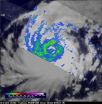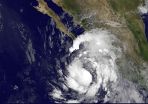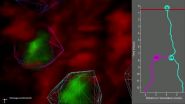Two NASA satellites stare at Typhoon Phanfone's large eye
2014-10-03
(Press-News.org) Two NASA satellites captured data on Typhoon Phanfone as it continues to strengthen as it moves through the Northwestern Pacific Ocean.
The Tropical Rainfall Measuring Mission or TRMM satellite flew over Typhoon Phanfone on Oct. 2, 2014 at 0939 UTC (5:39 a.m. EDT). The rainfall pattern observed using TRMM's Microwave Imager (TMI) and Precipitation Radar (PR) data showed that Phanfone was much better organized than a day earlier. This precipitation analysis revealed that intensifying typhoon Phanfone had formed a large eye. The heaviest rainfall was shown falling at a rate of over 50 mm (almost 2 inches) per hour in the northern side of the typhoon's eye wall.
On Oct. 3 at 0900 UTC (5 a.m. EDT), Typhoon Phanfone's maximum sustained winds were near 110 knots (126.6 mph/203.7 kph). It was centered near 23.6 north longitude and 134.4 east latitude, about 374 nautical miles west-southwest of the island of Iwo To. Phanfone has tracked northwestward at 12 knots (13.8 mph/22.2 kph).
The Joint Typhoon Warning Center (JTWC) predicts intensifying Phanfone's wind speeds will peak at 125 knots (144 mph) on October 3, 2014. The typhoon is then predicted to gradually weaken and it's track to re-curve toward the northeast and pass to the southeast of Tokyo, Japan on October 5-6, 2014.
INFORMATION:
[Attachments] See images for this press release:


ELSE PRESS RELEASES FROM THIS DATE:
2014-10-03
NASA's Terra satellite spotted the birth of Tropical Storm Vongfong in the Northwestern Pacific Ocean on Oct. 3. Vongfong is the nineteenth tropical storm of the Northwestern Pacific typhoon season.
The MODIS or Moderate Resolution Imaging Spectroradiometer instrument that flies aboard NASA's Terra satellite captured a visible image of Tropical Storm Vongfong on Oct. 3 at 00:30 UTC (Oct. 2 at 8:30 p.m. EDT). At the time of the image, the center of Tropical Storm Vongfong was located just to the northeast of Pohnpei, one of four states in the Federated States of Micronesia. ...
2014-10-03
Tropical Storm Simon is following the path of several other tropical storms that formed in the Eastern Pacific Ocean by crawling northward along the western coastline of Mexico. NOAA's GOES-West satellite captured an infrared image of Simon on Oct. 3 that showed the eastern side of the storm over Mexico.
An infrared image taken from NOAA's GOES-West satellite on Oct .3 at 7:45 a.m. EDT showed strong thunderstorms circling Tropical Storm Simon's center and a fragmented band of thunderstorms in Simon's eastern quadrant bringing rainfall to western Mexico. Simon's center ...
2014-10-03
Scientists at the U.S. Department of Energy's Argonne National Laboratory have created a new model to more accurately describe the greenhouse gases likely to be released from Arctic peatlands as they warm. Their findings, based on modeling how oxygen filters through soil, suggest that previous models probably underestimated methane emissions and overrepresented carbon dioxide emissions from these regions.
Peatlands, common in the Arctic, are wetlands filled with dead and decaying organic matter. They are the result of millions of years of plants dying and breaking down ...
2014-10-03
It has become common for people who have pets to refer to themselves as "pet parents," but how closely does the relationship between people and their non-human companions mirror the parent-child relationship? A small study from a group of Massachusetts General Hospital (MGH) researchers makes a contribution to answering this complex question by investigating differences in how important brain structures are activated when women view images of their children and of their own dogs. Their report is being published in the open-access journal PLOS ONE.
"Pets hold a special ...
2014-10-03
West Orange, NJ. October 3, 2014. Stroke researchers have confirmed that damage to the right frontal-subcortical network may cause ipsilateral spatial neglect. Among individuals with ipsilateral neglect, a much greater proportion had frontal subcortical damage than anticipated by the investigators – 83% vs the expected 27%. A difference was also seen in spatial bias, ie, the type of spatial errors among this group tended to be 'where' (perceptual-attentional) rather than 'aiming' (motor-intentional) errors. Ipsilesional Neglect: Behavioral and Anatomical Correlates (doi: ...
2014-10-03
A powerful scientific tool for editing the DNA instructions in a genome can now also be applied to RNA, the molecule that translates DNA's genetic instructions into the production of proteins. A team of researchers with Berkeley Lab and the University of California (UC) Berkeley has demonstrated a means by which the CRISPR/Cas9 protein complex can be programmed to recognize and cleave RNA at sequence-specific target sites. This finding has the potential to transform the study of RNA function by paving the way for direct RNA transcript detection, analysis and manipulation.
A ...
2014-10-03
VIDEO:
A software program developed by engineers at Drexel University, called Lineage Editing and Validation (LEVER), allows biologists to tag and track cell proliferation to validate lineage trees.
Click here for more information.
For hundreds of years biologists have studied cells through the lens of a microscope. With a little help from a team of engineers at Drexel University, these scientists could soon be donning 3-D glasses in a home-theater-like lab to take their own ...
2014-10-03
FALLS CHURCH, Va. (October 3, 2014) — A new National Institute for Occupational Safety and Health (NIOSH) study, published online in the Journal of Occupational and Environmental Hygiene, found that recommended safe handling practices for workers who administer antineoplastic drugs in healthcare settings are not always followed.
Results are derived from the 2011 Health and Safety Practices Survey of Healthcare Workers, the largest federally-sponsored survey of healthcare workers in the U.S., which addresses safety and health practices relative to use of hazardous chemicals. ...
2014-10-03
Washington, DC—The Endocrine Society today issued a Clinical Practice Guideline (CPG) advising against the use of testosterone therapy in healthy women.
The CPG, entitled "Androgen Therapy in Women: A Reappraisal: An Endocrine Society Clinical Practice Guideline," was published online in the Journal of Clinical Endocrinology and Metabolism (JCEM), a publication of the Endocrine Society. The Society updated its 2006 recommendations to address new research concerning testosterone and dehydroepiandrosterone (DHEA) therapy in women as well as advances in testosterone testing ...
2014-10-03
Luis Fernando Velásquez-García's group at MIT's Microsystems Technology Laboratories (MTL) develops dense arrays of microscopic cones that harness electrostatic forces to eject streams of ions.
The technology has a range of promising applications: depositing or etching features onto nanoscale mechanical devices; spinning out nanofibers for use in water filters, body armor, and "smart" textiles; or propulsion systems for fist-sized "nanosatellites."
In the latest issue of the IEEE Journal of Microelectromechanical Systems, Velásquez-García, his graduate students Eric ...
LAST 30 PRESS RELEASES:
[Press-News.org] Two NASA satellites stare at Typhoon Phanfone's large eye






